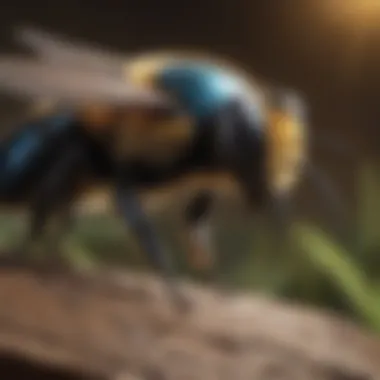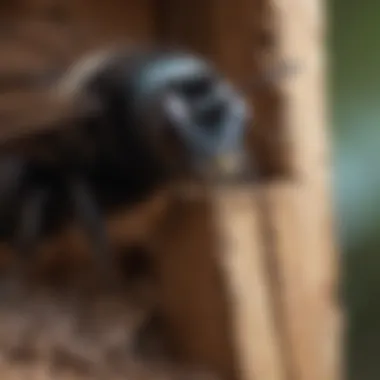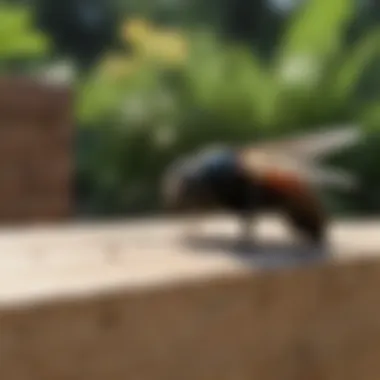Effective Strategies to Remove Carpenter Bee Nests


Intro
Carpenter bees, distinct from honeybees, are notorious for drilling into wooden structures to create nests. Their nesting behavior not only poses a threat to the integrity of your home but also can lead to significant lumber damage over time. Identifying and effectively eliminating carpenter bee nests is crucial for homeowners who wish to maintain their property’s aesthetics and longevity. This article will provide a thorough examination of strategies needed to deal with these pests. By understanding their biology and habits, readers will be equipped with the knowledge necessary to both eliminate existing nests and prevent future infestations.
Understanding Carpenter Bees
Carpenter bees are large, solitary insects that resemble bumblebees but lack the fuzzy appearance. This characteristic makes them stand out, yet it is their destructive nesting habits that demand attention. Females carve out tunnels in untreated or weathered wood, often found in eaves, decks, and furniture. Understanding their life cycle helps in planning effective control strategies.
Key Strategies for Identification
To manage a carpenter bee issue, one must first accurately identify their presence:
- Look for round holes roughly a half-inch in diameter.
- Observe the behavior of the bees, especially during spring when they are most active.
- Check for sawdust-like frass around nesting sites, which indicates excavation.
Gaining familiarity with their nesting patterns and behaviors enables homeowners to react promptly, minimizing damage.
Elimination Techniques
Once identified, the next step is elimination. Here are effective methods:
- Insecticidal Treatments: Apply a targeted insecticidal dust into the nest. Products containing deltamethrin are often effective.
- Sealing Entry Points: After confirming the bees are gone, seal nest entry points with caulk or wood putty to prevent reuse.
- Physical Removal: Use a vacuum with a long attachment to remove the bees, if safe to do so, after proper identification. This method is direct but must be handled cautiously to avoid bee stings.
- Natural Repellents: Solutions like peppermint oil or vinegar can deter bees, making your property less inviting. These are environmentally friendly alternatives that may also prevent future infestations.
Preventive Measures
Preventing carpenter bees from establishing nests is critical for long-term success:
- Wood Treatments: Regularly stain or paint wooden surfaces. Carpenter bees prefer untreated wood.
- Professional Inspections: Consider periodic pest control services to monitor and treat potential nests early.
- Design Adjustments: Reevaluate landscaping features and structural elements that may attract carpenter bees. Avoid overhanging plants that may provide access to wood.
Closure
The fight against carpenter bees requires diligence and awareness. Through effective identification and elimination strategies, homeowners can preserve their properties while implementing preventive measures ensures future infestations remain at bay. By understanding the lifecycle and habits of carpenter bees, one can confidently protect their home and garden.
Understanding Carpenter Bees
Carpenter bees, often mistaken for bumblebees, require a nuanced understanding for effective management. Recognizing their characteristics and behaviors is crucial in developing strategies to eliminate their nests. By comprehending their biology, nesting preferences, and behavioral patterns, homeowners can take informed steps toward prevention and removal. This knowledge helps to mitigate potential damage to wooden structures, promoting a harmonious cohabitation with the natural environment.
Biological Characteristics
Carpenter bees are large, robust insects resembling bumblebees. Their bodies are typically glossy and come in shades of black and yellow. A distinctive feature is the lack of hair on their abdomen, unlike bumblebees, which possess a furry body. This characteristic aids in identification.
These bees can reach up to an inch in length and show sexual dimorphism; male and female carpenter bees can be distinguished by their coloration. The females are more aggressive than males and are responsible for nesting. Their sting can be unpleasant but is rarely life-threatening to humans.
Nesting Preferences
Carpenter bees have specific nesting preferences that dictate where they will establish their colonies. They prefer untreated wood for nesting sites, particularly softwoods. Common choices include cedar, pine, and redwood. The wood must be weathered and can often be found in surfaces like eaves, decks, and fences. The females burrow into the wood, creating tunnels that can extend several feet long.
They may also decide to reuse old nests, which emphasizes the necessity of monitoring and maintaining wooden structures. Understanding these nesting preferences allows homeowners to inspect and address vulnerable areas of their property promptly.
Behavioral Patterns
Carpenter bees exhibit distinctive behavioral patterns that are essential for effective management. Males are territorial and can be seen buzzing near their nests, showcasing boldness but not aggression. They lack the ability to sting and tend to engage in displays to deter intruders.
In contrast, the females are the architects of their nests, tending to the eggs and larvae once they have laid them. Females will defend their nesting site if threatened, making it important to exercise caution during removal. Their activity levels peak during warmer months, making late spring and summer the prime time for spotting their presence.
Understanding these behavioral nuances can aid in strategizing the most effective times and methods for addressing infestations.


In sum, a comprehensive grasp of the biological characteristics, nesting preferences, and behavioral patterns of carpenter bees allows homeowners to approach the management of these pests with confidence and clarity.
Identifying Carpenter Bee Infestations
Identifying carpenter bee infestations is essential for effective management. Recognizing the signs early can save homeowners from extensive damage and costly repairs. Carpenter bees excavate tunnels in wood for nesting, and these tunnels can weaken structural integrity over time. Understanding how to spot these bees and their nests will help in prompt action to eliminate them. Not only is immediate identification crucial for protecting your property, but it also lays the groundwork for effective removal strategies.
Signs of Infestation
There are several telltale signs of a carpenter bee infestation. Homeowners should be vigilant in observing their surroundings. Key indicators include:
- Drilling Holes: Bee activity often presents as circular holes, usually 1/2 inch in diameter, in wooden structures.
- Sawdust Piles: Fine sawdust may collect beneath the holes as bees tunnel inside. This dust can be a major clue to their presence.
- Presence of Bees: Adult carpenter bees are often seen hovering around their nesting areas, particularly in the spring.
- Buzzing Sounds: A consistent buzzing noise can be heard if the nests are near. This is particularly evident when bees are active throughout the day.
Identifying these signs as soon as possible allows for timely intervention.
Common Nest Locations
Carpenter bees typically prefer nesting in specific areas. Understanding where they build their nests can help in both identification and removal. Common locations include:
- Unfinished Wood: Raw, untreated wood is highly attractive to carpenter bees. This includes decks, fences, and wooden furniture.
- Eaves and Overhangs: Areas that offer protection from the elements, like eaves, are typical nesting spots.
- Wooden Structures: Any wooden features, such as swingsets or gazebos, can be targeted by these bees due to their softer wood.
- Proximity to Flowers: Often, nests are found in locations close to flowering plants, as these provide food sources for adult bees.
By knowing these common nesting areas, homeowners can conduct thorough checks around their properties, allowing for an early response to potential infestations.
Preparation for Removal
Preparation for removal is crucial when addressing carpenter bee nests. Proper preparation not only ensures effective elimination but also reduces the risk of injury or further infestation. This section examines the key elements required for preparing to remove carpenter bees from your property successfully.
Safety Considerations
Safety is paramount when dealing with carpenter bee removal. These bees can be aggressive if provoked, especially if they feel their nest is threatened. The following steps should be taken:
- Protective Gear: Always wear long sleeves, gloves, and goggles to shield yourself from potential stings. If you're allergic to bee stings, consider having an epinephrine auto-injector on hand.
- Timing: Plan your removal during the evening or early morning when carpenter bees are less active. This will minimize the chances of confrontations.
- Avoid Sudden Movements: Approach nests slowly. Quick movements can alarm the bees, triggering a defensive response.
Remember: Taking the time to ensure your safety can make a significant difference in the ease of your removal process.
Gathering Required Tools
Successful removal of carpenter bee nests requires specific tools to ensure efficiency and effectiveness. Having the right tools on hand prevents delays and complications during the process. Consider collecting the following items:
- Insecticidal Sprays: Choose a high-quality insecticide specifically designed for bees. These should have a long-reaching nozzle for applying from a distance.
- Dusting Powders: Such powders can target nests effectively. Look for those that can be applied in crevices and dark spaces where bees hide.
- Protective Equipment: In addition to general protective gear, consider dust masks if you are using powdered insecticides.
- Trapping Devices: If preferred, invest in specially designed traps. They help manage the bee population without direct removal efforts.
- Tools for Nest Removal: A drill and a putty knife can assist in accessing and removing the nests from wooden structures safely.
Taking these precautions and gathering the necessary tools will set the stage for an effective removal process, minimizing risks and improving the chances of success.
Methods for Eliminating Carpenter Bee Nests
Eliminating carpenter bee nests is crucial for homeowners who wish to protect their properties from damage. Carpenter bees can cause significant holes in wood surfaces, leading to aesthetic issues and structural damage. Understanding the available methods for removal allows for a tailored approach based on the severity of the infestation and personal preferences regarding safety and environmental concerns. This section delves into various strategies, including the use of chemical solutions, non-chemical methods, and professional services, each with its own advantages and considerations.
Chemical Solutions
Chemical solutions are often the most effective means of eliminating pests quickly. They are typically easy to apply, and their effectiveness is well documented. There are two main types to consider: insecticidal sprays and dusting powders.
Insecticidal Sprays
Insecticidal sprays are a popular choice for controlling carpenter bee populations. These sprays are known for their immediate knockdown effect on bees, which can significantly reduce the number of active bees in and around the nest. The key characteristic of insecticidal sprays is their ease of application, making them accessible for many homeowners.
An important aspect of insecticidal sprays is that they often contain a variety of active ingredients which can offer broad-spectrum effectiveness. This means that the spray not only targets carpenter bees but may also affect other unwanted insects. However, a notable disadvantage is that some chemical sprays may pose risks to beneficial insects or pets if not applied carefully. Therefore, it is vital to follow the instructions on the label closely for safety reasons.
Dusting Powders


Dusting powders offer another chemical option for the elimination of carpenter bee nests. The primary characteristic of dusting powders is their ability to cling to surfaces and penetrate nests effectively. This means that when carpenter bees come in contact with the powder, they are exposed to the insecticides, leading to their demise.
One of the unique features of dusting powders is that they can be applied in hard-to-reach areas, making them effective for nests hidden within the wood grain. Additionally, dusting powders generally have a longer residual effect, allowing for extended protection. However, like sprays, dusting powders may also have consequences for non-target species, so using them judiciously is essential.
Non-Chemical Solutions
For those looking to avoid chemical treatments, non-chemical solutions are available. These methods can be effective in managing carpenter bee nests without introducing pesticides into the environment.
Hand Removal
Hand removal is a straightforward, albeit labor-intensive, method for those comfortable with a direct approach. This method involves locating the nest and removing it manually. The advantage of hand removal is that it provides immediate results without the use of chemicals.
However, this method requires caution, as provoking the bees can lead to stings. Homeowners should be equipped with protective clothing and tools to perform this task safely. A notable disadvantage is that this technique may not be practical for larger infestations or for individuals who may be allergic to bee stings.
Trapping
Trapping is another effective method for controlling carpenter bee populations. This solution involves setting up traps designed to lure and capture bees. The key characteristic of trapping is its environmental sustainability, as it does not rely on chemicals to eliminate pests.
The unique feature of traps is their ability to capture bees without causing harm to the surrounding environment. However, traps may have variable success rates depending on the design and placement. They also require regular monitoring and maintenance to ensure effectiveness.
Professional Pest Control Services
Professional pest control services can provide an effective solution for those dealing with a significant carpenter bee infestation. These experts have access to specialized tools and knowledge, making them adept at identifying and treating nests effectively. They can evaluate the severity of the infestation, recommend appropriate treatment methods, and ensure safe application of any chemicals involved.
Post-Elimination Actions
After successfully eliminating carpenter bee nests, it is essential to focus on post-elimination actions. These steps ensure that the areas affected by infestation are left clean and safe, while also facilitating the detection of any damage caused during the nesting process. Ignoring this phase can lead to future problems and could potentially invite new infestations.
Cleaning the Area
Cleaning the area is a crucial step after removing carpenter bee nests. This process helps to eliminate any residual pheromones or scents that may attract new bees to the site. It is important to gather all materials from the nest removal, including any debris such as wood shavings and droppings. These materials can contain trace pheromones, which signal to other bees that it is a suitable nesting habitat.
To clean effectively, homeowners should:
- Use a vacuum cleaner with a HEPA filter to remove any loose debris.
- Wash surfaces with a mild detergent or a solution of soap and water.
- Ensure that all remnants of the nest are disposed of safely to discourage reoccupation.
Additionally, once the area is cleaned, inspect nearby surfaces for any signs of residual activity. Carpenter bees are persistent and might try to nest in locations that seem previously appealing, so thorough cleaning is necessary.
Inspecting for Damage
After cleaning, the next task involves inspecting the area for any damage left behind by carpenter bees. These pests often create tunnels in wood, which can compromise structural integrity. Ignoring this can lead to more extensive repairs in the future that could be costly and time-consuming.
When inspecting for damage, consider the following:
- Look for holes: Carpenter bees typically create circular holes in wood, usually measuring about a half-inch in diameter. Assess all surfaces and structures rather than just those that were visibly infested.
- Check for weakening: Press on areas around the holes to determine if the wood feels soft or spongy, indicating deeper damage.
- Assess surrounding areas: Carpenter bees may nest near the original site if the area is not properly maintained. Be vigilant and inspect adjacent wood structures as well.
This inspection should ideally be done every few months after the initial removal to ensure that no new infestations take place due to overlooked damage. Regular maintenance, including examining outdoor wooden structures, is key in ensuring that your home remains protected against future carpenter bee invasions.
Remember: Addressing any damage promptly can prevent further deterioration, keeping your home safe and sound.
Preventing Future Infestations
Preventing future infestations of carpenter bees is crucial for maintaining a pest-free environment in your home and garden. Understanding the behavior of these pests allows homeowners to take proactive measures, reducing the likelihood of a recurrence. Effective prevention can save time, money, and the potential damage that carpenter bees may cause to wooden structures.
Sealing Potential Nest Sites


One of the most effective strategies in preventing carpenter bees from nesting is sealing potential nesting sites. Carpenter bees favor untreated or weathered wood. Therefore, it is important to inspect all wooden structures, including decks, fences, and window frames, for vulnerabilities that can attract these insects.
By applying a high-quality sealant, you can deter carpenter bees. Consider using products designed to protect outdoor wood. Pay special attention to any holes or cracks; sealing these can greatly decrease the risk of nests forming. If you have existing nests, ensure these are eliminated prior to sealing the surfaces.
To enhance your prevention efforts, consider these specific actions:
- Use durable wood: If you are constructing or replacing wooden structures, opt for hardwoods or pressure-treated lumber, which are less appealing to carpenter bees.
- Paint or stain wood surfaces: The application of paint or a protective stain can not only improve aesthetics but also serve as a deterrent. Bees are less likely to tunnel into painted surfaces.
Using Repellents
In addition to sealing potential nest sites, using repellents can be an effective method for keeping carpenter bees at bay. Natural repellents can be particularly useful since they are less harmful to the environment. Substances like citrus oil, peppermint oil, or almond oil are known for their ability to repel carpenter bees.
To apply these natural repellents:
- Mix with water: Combine a few drops of the oil with water in a spray bottle and apply it to areas where you suspect carpenter bee activity.
- Regular application: Since these natural deterrents may wear off, reapplication is necessary, especially after rainfall.
Commercial repellents are also available. They can offer a more long-lasting effect than natural options. Always ensure that any products you use are specifically labeled as safe for residential areas and follow the manufacturer's instructions.
"Preventing carpenter bee infestations is not only about removal but also about understanding and addressing the factors that attract them."
By sealing potential nest sites and using effective repellents, you can create a less hospitable environment for carpenter bees. This not only protects your home but also contributes to maintaining an outdoor space that is pleasant and pest-free.
Long-Term Maintenance Strategies
Long-term maintenance strategies play a crucial role in ensuring that carpenter bee infestations do not return after initial removal efforts. Homeowners should be proactive in addressing potential nesting sites and respond effectively if an infestation occurs. This section discusses key elements, benefits, and considerations in maintaining a carpenter bee-free environment.
Regular Inspections
Conducting regular inspections is vital in the long-term strategy against carpenter bees. Schedule these inspections at least twice a year, ideally in early spring and late summer. During inspections, look for signs of activity around wooden structures, particularly those that are untreated or weathered.
Some specific areas to check include:
- Eaves and overhangs
- Decks and railing
- Wooden fences
- Logs and untreated wood piles
Spotting small holes or sawdust at the base of nests indicates a problem.
Regular inspections not only allow for early detection but also help identify structural weaknesses. This proactive approach enables timely repairs or preventive actions which are critical in reducing potential nesting sites.
Educating Yourself and Others
Knowledge is a powerful tool in managing carpenter bee issues. Educating yourself about their behavior, life cycle, and nesting preferences empowers you to make more informed decisions. Understanding that carpenter bees prefer exposed wood grants insights into how to protect your property effectively.
Moreover, sharing knowledge with family members or neighbors can lead to community-level management efforts. It is beneficial to inform others about:
- Common nesting habits and signs of infestation
- Best practices for sealing wood and maintaining structures
- Effective repellents or traps to deter carpenter bees
"Awareness in your neighborhood can greatly reduce the instances of carpenter bees, as these creatures tend to swarm areas with frequent reports of suitable nesting environments."
Building a community of awareness about carpenter bees can mitigate risks for all homeowners. Digital platforms, social media, and local forums can be used to share experiences and solutions, creating a supportive network.
Ending
The significance of addressing carpenter bee infestations cannot be overstated. This article detailed several strategies for effectively eliminating their nests, summarizing critical points that highlight the importance of timely action. Properly managing carpenter bees not only protects your home from structural damage but also ensures the safety of both people and pets who may inadvertently come in contact with these insects.
Summarizing Key Points
- Understanding the biology of carpenter bees is crucial in identifying their nests and behaviors. This knowledge aids in recognizing signs of infestation early.
- Preparation for removal, including safety measures and the right tools, sets the foundation for successful elimination efforts.
- Various methods of elimination were discussed, including chemical solutions, safe non-chemical techniques, and when to seek professional help.
- Post-elimination action such as cleaning and inspecting damaged areas can prevent future issues and protect the structural integrity of your property.
- Preventative measures like sealing potential nesting sites and using repellents can significantly reduce the chance of recurrent infestations.
- Long-term maintenance through regular inspections and educating yourself about pest behavior is critical for sustainable management.
By incorporating these strategies, homeowners can maintain a pest-free environment, thus enhancing their living spaces.
Final Thoughts on Carpenter Bee Management
To conclude, effectively managing carpenter bees requires a comprehensive and proactive approach. The methods laid out in this article provide a clear path towards elimination and prevention. Consider the long-term implications of your efforts, as a well-experienced homeowner must stay vigilant and proactive against possible infestations. The information shared here can greatly benefit anyone looking to safeguard their homes and enhance their environments. Stay informed, act promptly, and cultivate resilience against these pests.







